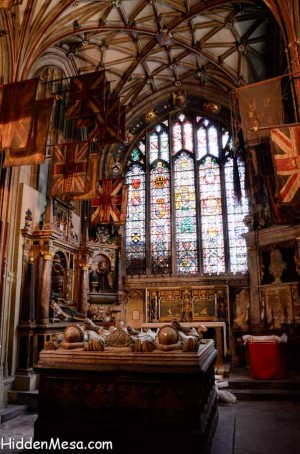Canterbury is a small medieval village located in the southern part of England near Dover . It’s believed that this area has been continuously inhabited since “prehistoric times”. Today, as a tourist destination, Canterbury is one of the most visited cities in the United Kingdom; probably because of the Canterbury Cathedral and the popularity of Geoffrey Chaucer’s 14th century collection of stories, The Canterbury Tales.
We visited the Canterbury Cathedral from a cruise ship docked at Dover. It was a short bus ride of about 20 miles to the village. And yes, they use “miles” in England. They also use “yards” and “Miles Per Hour”, but sell their fuel in liters.
In 597AD, Pope Gregory the Great sent a monk, by the name of Augustine to England as a missionary. The story goes that the Pope had seen a pair of young, fair haired slaves on the streets of Rome and had inquired about their origins. He was told that they were from England and misunderstood, thinking that the answer had been that the slaves had come from the “Land of Angels”. Thinking that the “Land of Angels” certainly needed to know about the church, he sent Augustine to spread the word. Upon arriving in England, Augustine found anything but the “Land of Angels”, but was given a warm welcome. It seems that the King’s wife was French and was already Christian. The Monk Augustine of course became the first Archbishop of Canterbury.
While the original Canterbury Cathedral was founded in 597 AD, it was re-built 1070-1077, and again in 1174. There have actually been many reconstructions due to fires and other mishaps over the centuries and any explanation of the architecture here would be a gross oversimplification of the facts. Suffice it to say that the architecture that makes up The Canterbury Cathedral ranges from Gothic to Perpendicular Gothic, Romanesque (Norman), and much more. We’ve tried to illustrate some of this as we walked about making images of the structures. You can see the different architectures in the image gallery here.
One incident that placed the Canterbury Cathedral on the map occurred on Tuesday, December 29, 1170. The knights of King Henry II murdered the Arch Bishop Thomas Becket, apparently because the King and the Archbishop didn’t get along. King Henry had made the statement , “who will rid me of this turbulent priest?”, and the knights took that as their cue to act. Of course, Arch Bishop Becket was popular among the faithful and this act transformed the Cathedral into a place of pilgrimage. The increase in popularity brought in much needed wealth to the church, which largely funded the various construction projects over the years.
 Up until around 1538, the Canterbury Cathedral was a Catholic Church. It was King Henry VIII that seized control of the Catholic churches in England and formed the Church of England and the Canterbury Cathedral was no exception. The story is that in 1538 King Henry VIII summoned the dead Saint Thomas (Archbishop Thomas Becket) to court to face charges of treason. Upon failing to appear, the King found him guilty and seized the treasures of his shrine. The treasure is said to have been carried off by two coffers and twenty three carts. We aren’t sure of the exact reasons why King Henry VIII would charge a dead person with treason, but we understand that the treasure that was amassed by pilgrims visiting the cathedral was considerable. We also understand that the King was in the midst of a dispute with the Pope because he wanted to divorce his wife, and the Pope would not allow it. You can of course draw your own conclusions about why Saint Thomas was charged with and found guilty of treason.
Up until around 1538, the Canterbury Cathedral was a Catholic Church. It was King Henry VIII that seized control of the Catholic churches in England and formed the Church of England and the Canterbury Cathedral was no exception. The story is that in 1538 King Henry VIII summoned the dead Saint Thomas (Archbishop Thomas Becket) to court to face charges of treason. Upon failing to appear, the King found him guilty and seized the treasures of his shrine. The treasure is said to have been carried off by two coffers and twenty three carts. We aren’t sure of the exact reasons why King Henry VIII would charge a dead person with treason, but we understand that the treasure that was amassed by pilgrims visiting the cathedral was considerable. We also understand that the King was in the midst of a dispute with the Pope because he wanted to divorce his wife, and the Pope would not allow it. You can of course draw your own conclusions about why Saint Thomas was charged with and found guilty of treason.
The day we visited Canterbury was a perfect spring day; something that is said to be sort of rare in the southern part of England, or anywhere in England for that matter. We found the Cathedral to be quite awe inspiring. Whether you’re of a religious nature of not, it’s very humbling to walk through a structure as beautiful as this one and know that it’s been in use, serving its faithful for over 1,400 years. Most Americans find anything that has more than 200 years of history to be fascinating anyway, but 1,400 years is very unusual.
There’s a fee to enter the Cathedral, but keep in mind that this has been a “pilgrimage” destination since the death of Archbishop Thomas Becket (later Saint Thomas) in 1170. While it’s still very much a working church, it serves its role as a pilgrimage and tourist destination and costs more than 18,500 pounds per day to operate, receiving nearly all of its funding from visitors.
The city of Canterbury, while older than the Cathedral, is a vibrant community. They’ve kept pace with the changing times and seem to have adjusted to the new role as tourist center quite easily. It seems almost natural to be able to visit the 1,400 year old Cathedral then enjoy a coffee in a building that is just as old, only re-purposed many times over. While enjoying your coffee you can use their free WiFi to check your email. Our only regret in visiting Canterbury was that we only had part of a day to explore. No doubt we’ll be back to spend more time in the future.
Here are a few more images of our visit in Canterbury.












Very informative!